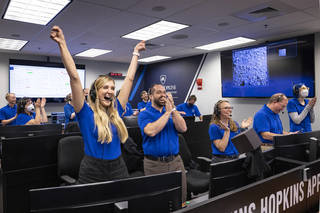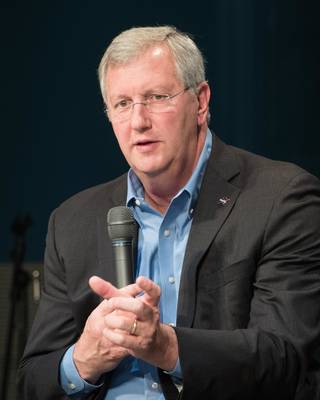NASA employees are among the finalists for this year’s Samuel J. Heyman Service to America Medals, also known as the Sammies, honoring outstanding federal employees who are addressing many of our country’s greatest challenges.
Selected from more than 350 nominations, Brian Key, Scott Bellamy, and NASA’s DART (Double Asteroid Redirection Test) team, are finalists for the Science, Technology and Environment award; and Ralph Roe, retired NASA chief engineer, is a finalist for the Career Achievement award.
Named for the Partnership for Public Service’s late founder, Samuel J. Heyman, an American businessman and philanthropist, these awards recognize federal employees who “break down barriers, overcoming huge challenges, and get results.”
“The DART team led by Brian Key and Scott Bellamy, and Ralph Roe are some of the very best of NASA, and we are beyond excited to see them recognized for their contributions and leadership,” said NASA Administrator Bill Nelson. “These individuals have shaped the course of human space exploration, inspiring everyday Americans through innovation. They are very deserving of this honor through the Sammie award.”
Science, Technology and Environment Award
NASA’s DART team are finalists for the Science, Technology and Environment Award. Managed by Brian Key and Scott Bellamy, the team directed a mission that, for the first time in human history, deflected an asteroid as a test for planetary defense.
NASA’s DART spacecraft launched in November 2021 and successfully impacted its target asteroid, Dimorphos, on Sept. 26, 2022. While Dimorphos posed no hazard to Earth, DART’s successful collision with the asteroid demonstrated one method of asteroid deflection, known as kinetic impactor technology.
Following the collision with the asteroid, the team continued to obtain and analyze data from ground-based telescopes and radar facilities around the world to understand the efficiency of momentum transfer from DART’s roughly 14,000-mile (22,530-kilometer) per-hour collision with its target. These data, in tandem with the images returned by various spacecraft and telescopes, are helping scientists understand the nature of the surface of Dimorphos, how much material was ejected by the collision, and how fast it was ejected – all factors that can help us determine how effectively this technique can modify an asteroid’s orbit.
Most recently, the DART team has received several top awards, including the National Space Club and Foundation Aerospace Award and the Space Foundation Achievement Award.
Career Achievement Award
Roe was named among the finalists for the Career Achievement Award. He was chosen for playing a pivotal role in reshaping the agency’s safety culture to ensure the next generation of successful human spaceflight.
Roe was serving as manager of the Space Shuttle Vehicle Engineering Office at NASA’s Johnson Space Center in Houston during the time of the Columbia accident and was in Shuttle Engineering at the Kennedy Space Center at the time of the Challenger accident, events that both dramatically impacted the course of his NASA career. He later went on to use lessons learned from the tragedies to conceptualize and become the first director for the agency’s Engineering and Safety Center (NESC), located at NASA’s Langley Research Center in Hampton, Virginia. The NESC provides the agency with technical expertise, skills, and resources to offer an independent look at the agency’s programs and products. Roe served as the NESC director until February 2014 when he was selected as NASA’s chief engineer.
His dedication for safety created a new standard for pre-operation evaluation, communication, and decision making across NASA. Roe was a role model for embracing safe attitudes and behaviors, keeping safety as a core value in all the agency’s missions and endeavors.
Since its inception in 2002, the Sammies have honored over 700 outstanding federal employees. Roe and the DART team are among 47 federal employees across 25 federal agencies honored as 2023 Sammies finalists for their outstanding contributions to safety, public health, and sustainability across our nation and the world.
All finalists are eligible for the Service to America Medals People’s Choice Award. Members of the public can also support the DART team and Roe by voting online starting on Friday, May 12.




























